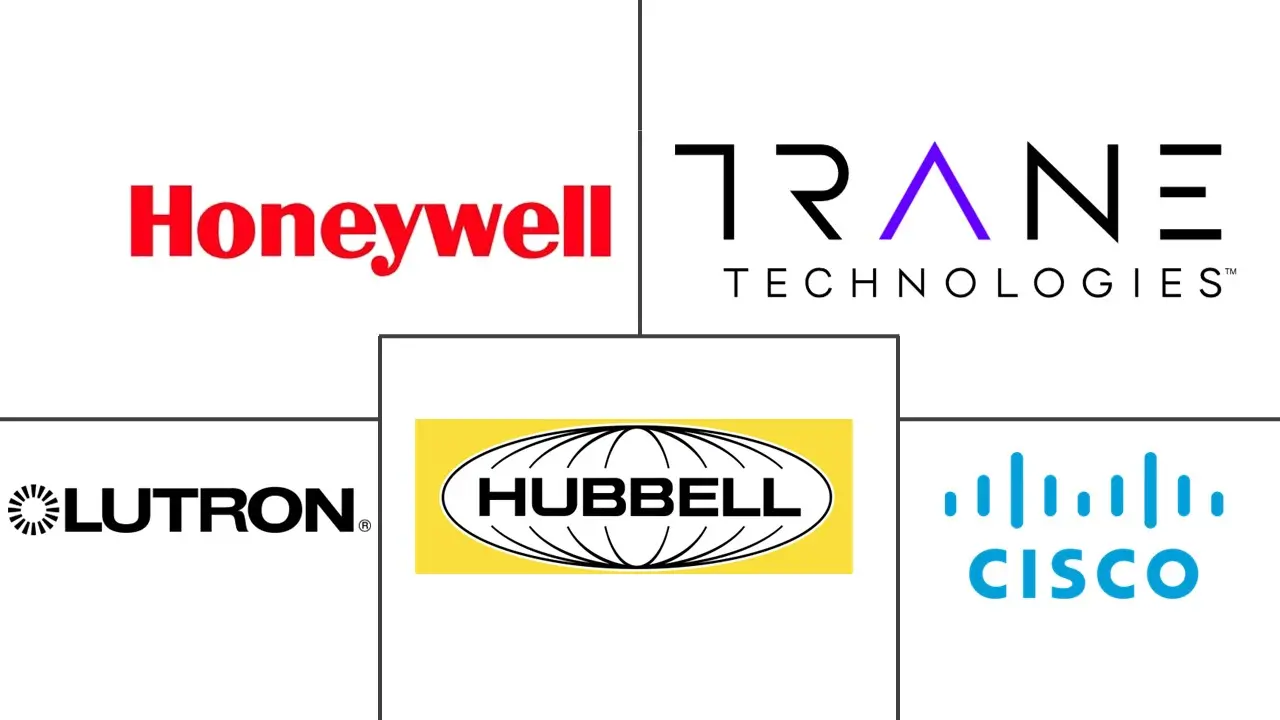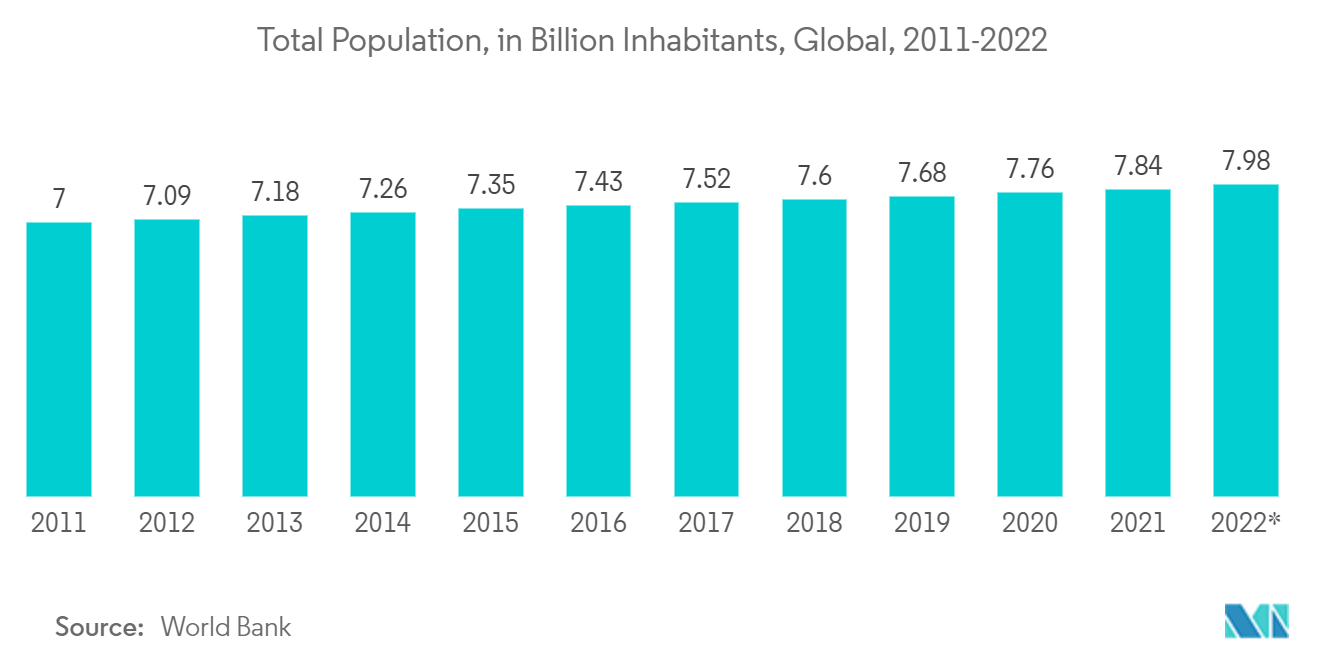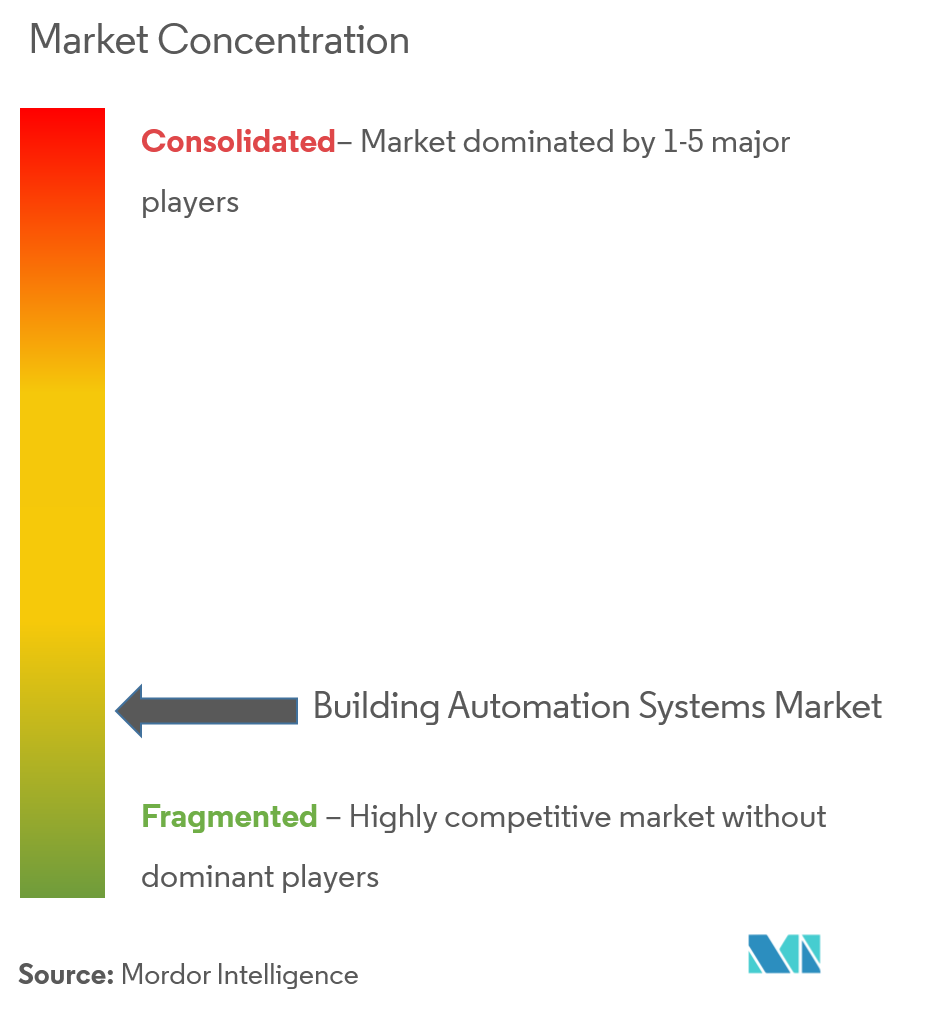Building Automation Systems Market Size

| Study Period | 2019 - 2029 |
| Market Size (2024) | USD 201.08 Billion |
| Market Size (2029) | USD 332.01 Billion |
| CAGR (2024 - 2029) | 10.55 % |
| Fastest Growing Market | Asia-Pacific |
| Largest Market | Europe |
Major Players
*Disclaimer: Major Players sorted in no particular order |
Building Automation Systems Market Analysis
The Building Automation Systems Market size is estimated at USD 201.08 billion in 2024, and is expected to reach USD 332.01 billion by 2029, growing at a CAGR of 10.55% during the forecast period (2024-2029).
A building automation system (BAS), also referred to as a building control system or a building management system, is a system that controls several electric, electronic, and mechanical systems throughout a building. The market report tracks the revenue accrued by the companies through the sale of building automation solutions worldwide. Components like building management systems, lighting controls, fire detection, HVAC controls, and security systems are included in the scope of the study and span across end users like residential and commercial.
- The global market for building automation systems has been driven by the increased popularity of the Internet of Things and rising security concerns. According to Cisco's Annual Internet Report, by the next year, nearly 30 billion network-connected devices and connections are expected to exist, increasing from 18.4 billion in 2018. IoT devices are expected to account for 50% (14.7 billion) of all networked devices by 2023, compared to 33% (6.1 billion) in 2018.
- According to the US Department of Energy, buildings are the single largest energy-consuming sector of the US economy. They account for approximately 75% of the nation's electricity use and 40% of its total energy demand. The International Energy Agency states that to hit global net-zero targets, all new buildings and 20% of existing buildings must be zero-carbon as soon as 2030.
- According to a report published in Proceedings of the National Academy of Sciences, in the next 50 years, 30% of the world's estimated population is expected to reside in regions where the average temperature is above 29°C due to climate change-related rapid temperature rise and population expansion. Currently, this climate only exists on less than 1% of the Earth's land surface, mainly in the hottest regions of the Sahara desert. But by 2070, these temperatures are expected to be present across about a fifth of the planet's terrestrial surface.
- With the growth of technology, smart buildings are growing more and more complex, requiring quicker follow-up looks via retro-commissioning. Adding to that, the risks associated with sustained operational integrity are also mounting. Hence, the demand for comprehensive building automation systems is expected to spike. It is very important to establish the necessary communication between the system providers/designers and owners of the buildings to understand the functioning of the building.
- With the COVID-19 outbreak, most commercial and industrial construction projects started at a slower pace, while some were canceled. Production lines at some HVAC manufacturers had to be put on hold for several weeks, and installers saw their new installation projects being limited by sanitary guidelines. However, in European countries such as Italy, AHU sales benefitted from the increased ventilation demand due to COVID-19.
Building Automation Systems Market Trends
This section covers the major market trends shaping the Building Automation Systems Market according to our research experts:
Surge in Demand for HVAC Housing, Owing to Rapid Population Growth
- According to the United Nations, there were 2.5 billion people in the world in 1950. There are about 8 billion as of 2022. It also projects that there are expected to be 10.4 billion people living on earth by the end of the century. Moreover, the IEA estimates that, by 2050, up to 2.5 billion individuals in hot countries are expected to own an air conditioner. Even though they would also need air conditioning, 1.9 billion individuals may be left out of the equation. According to this prediction, air conditioners may be used by 75% of people in hot nations by 2050.
- According to the International Monetary Fund, in 2021, the total population of the United States was approximately 332.18 million inhabitants. Such a rise in the population is expected to increase the demand for the construction of new homes, which is expected to drive the HVAC segment. HVAC firms are manufacturing new products to increase their market shares and are looking to expand into new markets.
- For instance, in May 2022, Johnson Controls-Hitachi introduced a new Wall Mount indoor mini-split unit as the latest addition to its PRIMARY P300 line of high-efficiency, single-zone commercial mini-split systems. This ductless heating and cooling system was developed to address the particular requirements of small to medium-sized spaces, such as retail establishments, dining establishments, and educational facilities. The new wall mount unit is small and lightweight, and the entire series of Hitachi PRIMARY mini-split systems have several mounting possibilities, making installation for contractors easier. Its long pipe adds to the layout freedom, and an extensive capacity range ensures a system is precisely the right size for any application.
- There is a greater need for consumer air conditioning due to the rising temperatures during summer, the overpopulation of large cities, and people's busy schedules. There are mounting concerns in the Asia-Pacific region, where air-conditioning systems are becoming more prevalent, affordable, and essential than ever before. There used to be little reliable air conditioning, but there is now a great need. This implies that the consumer housing market must offer acceptable living circumstances during the height of summer.
- According to the United Nations, Asia's population will likely be around 4.68 billion on July 1, 2021. Asia is the most populated continent, with approximately 3.5 times as many people as Africa, which is second. Before reaching a high in 2055 with 5.3 billion inhabitants, Asia is expected to gain another 620 million people. Nearly a third of the world's population is found in Asia.

Europe to Hold Significant Market Share with Germany Leading the Region's Growth
- In the current market scenario, security systems are gaining significant market traction in Germany due to increasing cases of theft and burglary. According to the Federal Criminal Police Office of Germany, over 1,483,000 thefts were reported in 2021. This further indicates the region's substantial untapped market potential for security systems.
- The rise in security concerns is also driving firms to provide new security products for buildings through product innovations and acquisitions. For instance, in October 2022, ASSA ABLOY acquired Bird Home Automation GmbH, a German manufacturer of high-quality IP door intercoms for single and multi-family buildings. This acquisition accelerates the company's growth in the residential segment.
- Europe is also witnessing unprecedented demand spikes in smart door locks from residential end users. Established market players capitalize on this demand by offering advanced smart door locks with several additional features.
- For instance, in September 2022, Ring announced a new wireless intercom device aimed at apartment dwellers. This intercom is designed to connect to most building-wide intercom systems used by apartment complexes to vet visitors and buzz them in. This intercom enables auto-verification for Amazon deliveries and approved guests, which would let them buzz themselves in without needing a door code or an extra fob.
- The rise in government policies and regulations toward energy efficiency, the requirement for security systems due to the increase in theft activities, and the increases in losses due to fire accidents are expected to drive the growth of building automation systems in the region. Various vendors are developing new products to satisfy customer needs.

Building Automation Systems Industry Overview
The Building Automation Systems Market is fragmented, with major players like Honeywell International Inc., Cisco Systems Inc., Trane Technologies, Lutron Electronics Co. Ltd, and Hubbell Inc. Companies are also increasing their market presence by introducing new products, expanding their operations, or by entering into strategic mergers and acquisitions.
- May 2022: Mitsubishi Electric Trane HVAC US, a leading provider of ductless and ducted mini-split and variable refrigerant flow (VRF) heat-pump and air-conditioning systems, announced the release of Building Connect+, an expanded version of the cloud-based controls and monitoring platform. Building Connect+ is a pre-engineered cloud-based secure control and monitoring platform for controlling and managing CITY MULTI systems and BACnet-enabled third-party devices.
- March 2022 - Hitachi Elevator Co. Ltd, a joint venture company of Hitachi Ltd and Siam Motors Group (the exclusive sales and service company of elevators and escalators in Thailand), announced that it had launched a full-scale Smart Building Solution business for the first time in Thailand and Southeast Asia. This aims to provide value to buildings with physical security system and digital service for the new normal by utilizing teh Lumada IoT platform.
Building Automation Systems Market Leaders
-
Honeywell International Inc.
-
Cisco Systems Inc.
-
Trane Technologies
-
Lutron Electronics Co. Ltd
-
Hubbell Inc.
*Disclaimer: Major Players sorted in no particular order

Building Automation Systems Market News
- September 2022: Honeywell International announced the Australian launch of Fire-lite, a suite of fire protection systems designed to meet the need of small and medium businesses. Mid-rise residential, warehouses, and retail spaces across Australia. Fire-Lite'scustomizable and intelligent addressable fire panels are designed to meet a range of building requirements by providing flexible solutions to support a variety of installations.
- March 2022: Trane Technologies announced its plans to expand its operations in Greenville country with an investment of USD 30 million. The company will add around 3,00,000 sq. ft of manufacturing capacity designed to enable and sustain the company's future growth.
Building Automation Systems Market Report - Table of Contents
1. INTRODUCTION
- 1.1 Study Assumptions and Market Definition
- 1.2 Scope of the Study
2. RESEARCH METHODOLOGY
3. EXECUTIVE SUMMARY
4. MARKET INSIGHTS
- 4.1 Market Overview
-
4.2 Industry Attractiveness - Porter's Five Forces Analysis
- 4.2.1 Threat of New Entrants
- 4.2.2 Bargaining Power of Buyers
- 4.2.3 Bargaining Power of Suppliers
- 4.2.4 Threat of Substitute Products
- 4.2.5 Intensity of Competitive Rivalry
- 4.3 Industry Value Chain Analysis
- 4.4 Impact of COVID-19 on the Industry
5. MARKET DYNAMICS
-
5.1 Market Drivers
- 5.1.1 Increasing Demand for Energy and Operational Efficiency, Supported by Government Initiatives
-
5.2 Market Challenges
- 5.2.1 Absence of Technology Alignment and High Acquisition and Implementation Costs
6. MARKET SEGMENTATION
-
6.1 By Component (Market Sizing and Forecast, Trends, and Dynamics)
- 6.1.1 Hardware (Controllers and Field Devices)
- 6.1.2 Software
- 6.1.3 Services
-
6.2 By End User (Market Sizing and Forecast, Trends, and Dynamics)
- 6.2.1 Residential
- 6.2.2 Commercial
- 6.2.3 Industrial
-
6.3 By Geography
- 6.3.1 North America
- 6.3.2 Europe
- 6.3.3 Asia Pacific
- 6.3.4 Latin America
- 6.3.5 Middle East and Africa
7. COMPETITIVE LANDSCAPE
-
7.1 Company Profiles
- 7.1.1 Honeywell International Inc.
- 7.1.2 Cisco Systems Inc.
- 7.1.3 Trane Technologies
- 7.1.4 Lutron Electronics Co. Ltd
- 7.1.5 Hubbell Inc
- 7.1.6 United Technologies Corporation
- 7.1.7 Hitachi Ltd
- 7.1.8 Huawei Technologies Corporation
- 7.1.9 Emerson Electric Co.
- 7.1.10 Mitsubishi Electric Corporation
- *List Not Exhaustive
8. INVESTMENT ANALYSIS
9. FUTURE OF THE MARKET
** Subject To AvailablityBuilding Automation Systems Industry Segmentation
Building automation systems exhibit functions such as control of the building's environment, operating systems depending on the energy demand, and monitoring the system performance, based on which the systems produce sound alerts as required. Moreover, it centrally controls the building's heating, ventilation, and air conditioning (HVAC), electrical, lighting, shading, access control, security systems, and other interrelated systems.
Building automation systems (BASs) or building automation control systems exhibit functions such as control of the building's environment and operating systems (depending on the energy demand) and monitor the system performance, based on which the systems produce sound alerts as required. A BAS has related hardware and software for controlling and monitoring electrical systems, heating, ventilation, air-conditioning (HVAC), lighting control, security, and surveillance in buildings.
The report on the building automation systems market is segmented by component (hardware, software, services), end-user (residential, commercial, industrial), and geography (North America, Europe, Asia-Pacific, Latin America, and Middle East and Africa). The market sizing and forecasts are provided in terms of value (USD billion) for all the above segments.
| By Component (Market Sizing and Forecast, Trends, and Dynamics) | Hardware (Controllers and Field Devices) |
| Software | |
| Services | |
| By End User (Market Sizing and Forecast, Trends, and Dynamics) | Residential |
| Commercial | |
| Industrial | |
| By Geography | North America |
| Europe | |
| Asia Pacific | |
| Latin America | |
| Middle East and Africa |
Building Automation Systems Market Research FAQs
How big is the Building Automation Systems Market?
The Building Automation Systems Market size is expected to reach USD 201.08 billion in 2024 and grow at a CAGR of 10.55% to reach USD 332.01 billion by 2029.
What is the current Building Automation Systems Market size?
In 2024, the Building Automation Systems Market size is expected to reach USD 201.08 billion.
Who are the key players in Building Automation Systems Market?
Honeywell International Inc., Cisco Systems Inc., Trane Technologies, Lutron Electronics Co. Ltd and Hubbell Inc. are the major companies operating in the Building Automation Systems Market.
Which is the fastest growing region in Building Automation Systems Market?
Asia-Pacific is estimated to grow at the highest CAGR over the forecast period (2024-2029).
Which region has the biggest share in Building Automation Systems Market?
In 2024, the Europe accounts for the largest market share in Building Automation Systems Market.
What years does this Building Automation Systems Market cover, and what was the market size in 2023?
In 2023, the Building Automation Systems Market size was estimated at USD 181.89 billion. The report covers the Building Automation Systems Market historical market size for years: 2019, 2020, 2021, 2022 and 2023. The report also forecasts the Building Automation Systems Market size for years: 2024, 2025, 2026, 2027, 2028 and 2029.
Which sectors are driving the demand for the Business Automation System (BAS) Market?
Major sectors driving the demand for BAS Market are commercial buildings, residential complexes, industrial facilities, and government infrastructure, with commercial buildings being the largest users.
Building Automation Systems Industry Report
The building automation system market is experiencing significant growth, driven by the increasing demand for energy efficiency and enhanced security in both residential and commercial sectors. The integration of Internet of Things (IoT) technology has led to a rise in interconnected devices, thereby boosting the demand for advanced building automation solutions. These systems, encompassing HVAC, lighting, and security, are essential for optimizing operations, reducing energy consumption, and ensuring occupant comfort and safety.
The market is also benefiting from the integration with renewable energy sources, aligning with the global push for sustainability. Rapid urbanization and heightened awareness of automation benefits in building management are further propelling the market forward. Technological advancements, such as wireless protocols and sensor networks, are making these systems more accessible and efficient.
Despite challenges like technical complexities and the need for skilled professionals, the building automation system market size is set for significant growth, driven by smart, energy-efficient building trends. Mordor Intelligence™ Industry Reports provide a comprehensive market overview and insights into the building automation systems analysis. For detailed statistics on market share, size, revenue growth rate, and a forecast outlook, access a free report PDF download.
The industry is characterized by a robust market growth, supported by extensive industry research and market data. The market forecast indicates a positive market outlook, with industry trends pointing towards increased adoption of smart technologies. The industry analysis reveals that market leaders are continuously innovating to stay ahead in this competitive landscape.
The market segmentation includes various components such as hardware, software, and services, catering to different end-users like residential, commercial, and industrial sectors. The market value is expected to rise as companies leverage industry information and industry statistics to make informed decisions.
In summary, the building automation and control system market is poised for substantial growth, with industry reports highlighting the importance of energy efficiency and security. The market review suggests that industry sales will continue to rise, driven by technological advancements and the increasing need for smart building solutions. For a detailed market segmentation and industry outlook, refer to the comprehensive industry reports available.



